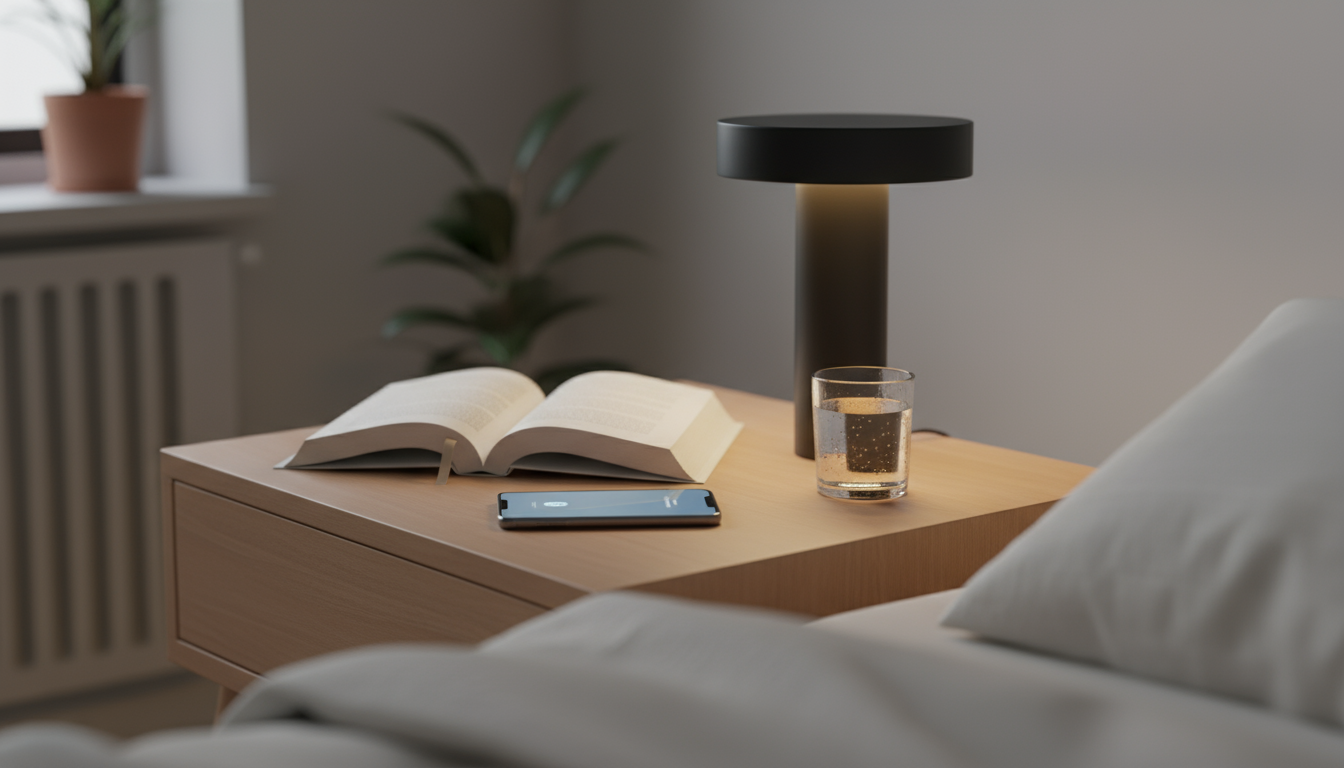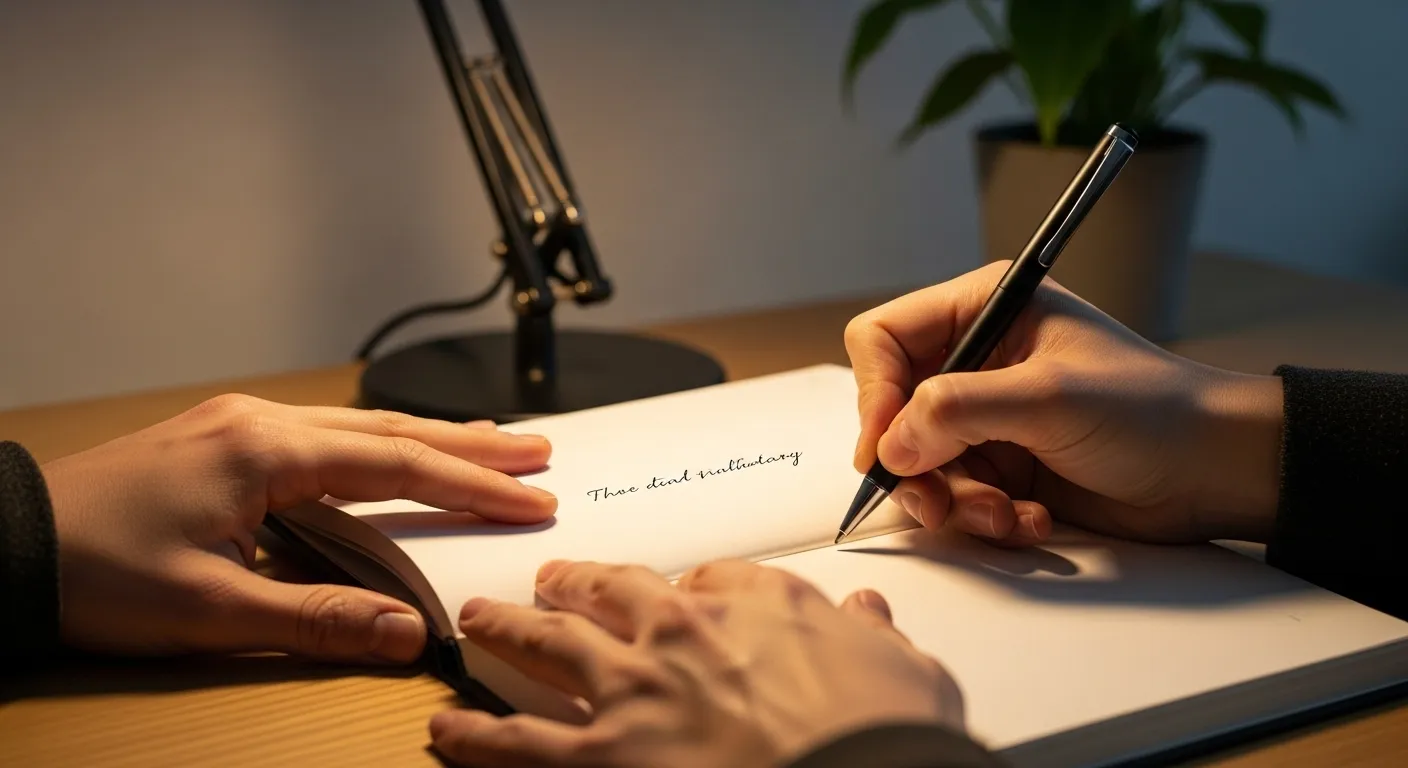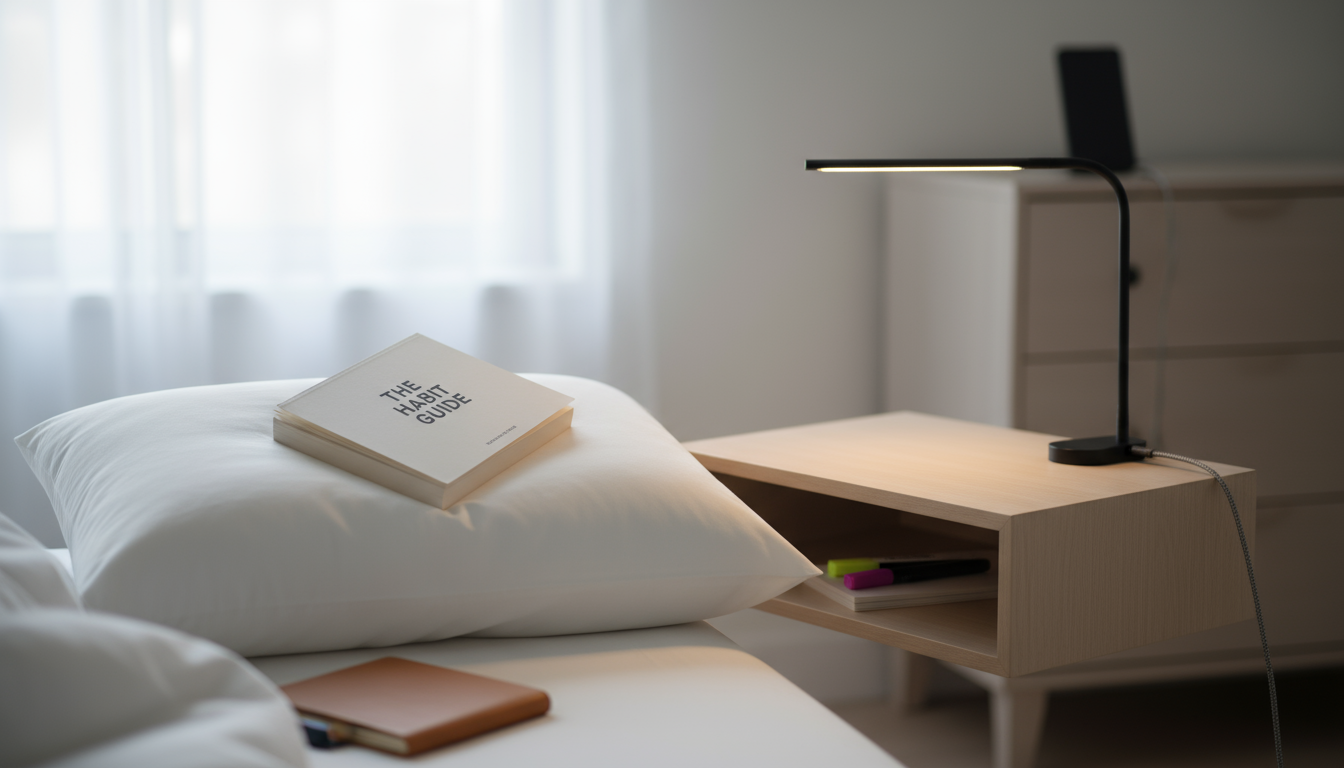
You’ve tried it before. You read an article about the world’s most successful CEOs, and they all wake up at 4:30 AM, meditate for an hour, and drink a kale smoothie before conquering the world. Inspired, you set your alarm. You vow that tonight, you will put your phone away at 8 PM sharp, read a chapter of a serious book, and journal about your long-term goals. Tonight, everything changes.
But then, tonight happens. A stressful day at work bleeds into your evening. The city hums with a constant, low-grade urgency outside your window. Your phone buzzes with one last email, one more notification, one more endlessly scrolling feed. Your willpower, which felt so robust this morning, now feels like a frayed piece of string. The couch calls, the TV beckons, and the promise of a radical transformation dissolves into the familiar comfort of distraction. You go to bed late, feeling a pang of guilt, and promise yourself that tomorrow, you’ll really do it.
If this cycle sounds familiar, you are not alone, and more importantly, you are not failing. The problem isn’t your willpower; it’s your strategy. Willpower is a finite resource, especially for those of us navigating the demands of modern urban life, a landscape designed for distraction. Relying on sheer force of will to build a better life is like trying to build a house in a hurricane. Instead, we need a different approach—one that is gentle, systematic, and built on the quiet power of tiny, consistent steps. This guide isn’t about a revolutionary overhaul of your life overnight. It’s about building a productive nightly routine so subtly and sustainably that it becomes a natural part of who you are, leading not to burnout, but to durable, meaningful change.
📚 Table of Contents
- Understanding the Mechanics of a Habit
- Designing Your Productive Nightly Routine: The Four Pillars
- Pillar 1: Start with a Minimum Viable Action
- Pillar 2: Conduct a Friction Audit
- Pillar 3: Engineer Your Environment with Cues and Habit Stacking
- Pillar 4: Use Gentle Accountability
- Safeguarding Your Progress: What to Do When You Slip Up
- Worked Examples: Two Simple Routines in Action
- Frequently Asked Questions About Building a Nightly Routine
- How long does it really take to build a new habit?
- What should I do on travel days, sick days, or holidays?
- I was doing great, but now I’ve hit a plateau. What’s wrong?
- Can I try to build multiple new habits for my evening routine at once?
- Your First Steps to a Lasting Evening Routine

Understanding the Mechanics of a Habit
Before we can build a new routine, we need to understand how our brains are already wired. Habits aren’t magic; they are neurological loops that our brains create to save energy. Think about the first time you drove a car—every turn, every check of the mirror, every press of the pedal required intense focus. Now, you likely drive to work on autopilot. That’s a habit at work. Understanding this process allows us to work with our brains, not against them.

The Habit Loop: Cue, Action, Reward
At the core of every habit is a simple, three-step neurological pattern that researchers at MIT first identified. We call it the habit loop, and it consists of a cue, an action (or routine), and a reward.
The Cue: This is the trigger, the thing that tells your brain to go into automatic mode and which habit to use. A cue can be a time of day (like 7 PM), a location (your couch), a preceding event (finishing dinner), an emotional state (feeling stressed), or the presence of other people. For a bad habit, the cue might be the buzz of your phone on the nightstand. For a good one, it could be the sight of your book waiting on your pillow.
The Action: This is the habit itself—the physical or mental routine you perform. It’s the act of picking up your phone, or grabbing the TV remote, or lacing up your running shoes. This is the part we tend to focus on most, but it’s only one piece of the puzzle.
The Reward: This is the final and most crucial step. The reward is what tells your brain, “Hey, this loop is worth remembering for the future.” The reward satisfies a craving. The reward for scrolling social media might be a hit of dopamine from social connection or distraction from stress. The reward for a healthy evening routine might be a feeling of calm, a sense of accomplishment, or the deep satisfaction of preparing for a successful tomorrow. Without a satisfying reward, a habit won’t stick.
When you try to force a new habit using willpower alone, you are often ignoring the cue and the reward. You’re just trying to jam a new action into your life. The key to a sustainable nightly routine is to consciously design this entire loop, making the cue obvious, the action easy, and the reward satisfying.

Identity-Based Habits: Becoming the Person You Want to Be
Beyond the simple mechanics of the habit loop, there’s a deeper, more powerful way to frame your journey. Many of us approach habits with an outcome-based mindset: “I want to lose 10 pounds,” or “I want to read 20 books this year.” These are great goals, but they aren’t great for building habits.
A more effective method is to focus on identity-based habits. This means shifting your focus from what you want to achieve to who you wish to become. Instead of saying, “I want to read every night,” you frame it as, “I am a person who reads.” Instead of, “I need to tidy my apartment,” you think, “I am an organized person who maintains a clear space.”
This may seem like a simple semantic trick, but it’s a profound psychological shift. Every time you perform a small action that aligns with your desired identity, you cast a vote for that identity. Reading one page of a book isn’t just reading a page; it’s a vote for being “a reader.” Tidying your desk for two minutes isn’t just cleaning; it’s a vote for being “an organized person.” The goal is not to achieve a single outcome, but to become the kind of person who achieves those outcomes naturally. A truly productive nightly routine isn’t something you do; it’s a reflection of who you are: a person who values rest, preparation, and peace.

Designing Your Productive Nightly Routine: The Four Pillars
Now that we understand the “why” and “how” of habits, we can move to the practical part: designing a routine that works for you. Forget the complex, hour-long rituals you see online. We’re going to start small and build a foundation based on four simple pillars: making it easy, making it obvious, making it attractive, and making it satisfying.

Pillar 1: Start with a Minimum Viable Action
The single biggest mistake people make when building a new habit is starting too big. Your motivation will be highest on day one, but motivation is fickle. We need a system that works even on your worst, most tired days. This is where the concept of a Minimum Viable Action comes in. It’s the smallest, simplest version of your desired habit, an action so easy you can’t say no to it.
Think about the habit you want to build. Now, shrink it. Then shrink it again.
- Want to meditate for 20 minutes? Your Minimum Viable Action is to sit and take one deep breath.
- Want to journal for a page? Your Minimum Viable Action is to write one sentence.
- Want to tidy your entire apartment? Your Minimum Viable Action is to put one thing back in its place.
The point of the Minimum Viable Action isn’t the action itself; it’s the act of showing up. It builds the neural pathway for consistency. You can always do more—and often you will—but on days when you have zero energy, you can still perform your one-sentence journal entry, cast that vote for your new identity, and keep the chain of consistency alive. This is fundamental to creating durable habits for better sleep and next-day productivity.

Pillar 2: Conduct a Friction Audit
Every action in our lives has a certain amount of friction associated with it. Friction is the collection of small obstacles that stand between you and doing something. To build good habits, our job is to decrease friction. To break bad habits, we increase it. This is a core part of designing your environment for success.
Let’s conduct a quick friction audit for a common goal within a nightly routine: reading a book instead of scrolling on your phone.
To decrease friction for reading:
- Place the book you want to read directly on your pillow in the morning.
- Keep a small reading light on your nightstand, within arm’s reach.
- Choose a book you are genuinely excited to read, not one you feel you “should” read.
To increase friction for phone scrolling:
- Move your phone charger to another room, like the kitchen or office.
- Set your phone to grayscale mode in the evening to make it less visually appealing.
- Delete the most distracting apps, forcing you to log in through a web browser.
- Put your phone inside a drawer or box at a set time.
By making your desired habit the path of least resistance, you no longer need to rely on willpower. You’ll simply gravitate toward the easiest option, which you have cleverly designed to be the better one.

Pillar 3: Engineer Your Environment with Cues and Habit Stacking
Your environment is one of the most powerful and invisible forces shaping your behavior. The most disciplined people are often not those with superhuman willpower, but those who have designed their environments to make good habits inevitable. We can do this by creating powerful visual cues.
If you want to prepare your lunch for the next day, leave the container out on the counter right after you finish dinner. If you want to drink a glass of water, place the glass by the sink. These physical cues interrupt your autopilot and prompt the desired action.
An even more powerful technique is habit stacking. This method involves anchoring a new habit you want to build onto an existing one that you already do without thinking. The formula is simple: “After I [CURRENT HABIT], I will [NEW HABIT].”
- “After I brush my teeth, I will lay out my clothes for tomorrow.”
- “After I finish washing the dinner dishes, I will write down my top priority for the next day.”
- “After I get into bed, I will read one page of my book.”
The existing habit (brushing your teeth) becomes the cue for the new habit (laying out your clothes). This is incredibly effective because you’re not trying to find a new time or place for your habit; you’re simply bolting it onto a process that’s already running on autopilot.

Pillar 4: Use Gentle Accountability
While the internal drivers of identity are paramount, external support can be a powerful motivator. Accountability doesn’t have to mean a drill sergeant yelling at you. It can be a gentle, supportive force.
You could simply tell a friend or partner about the small habit you’re trying to build. For example, “I’m trying to put my phone away at 9 PM every night this week.” The simple act of saying it out loud can make it feel more real. Alternatively, you can use a simple habit tracker—a calendar on the wall where you put an ‘X’ on each day you complete your minimum viable action. The goal isn’t to achieve a perfect, unbroken streak, but to create a visual record of your effort, which can be incredibly rewarding and motivating.

Safeguarding Your Progress: What to Do When You Slip Up
No journey of change is a perfect, straight line. You will have days where you’re sick, traveling, or overwhelmed. Life will happen. The most important part of building a durable habit isn’t avoiding failure; it’s having a plan for when it inevitably occurs. A truly sustainable system is not one that is rigid and fragile, but one that is flexible and resilient.

Plan for Relapse: The “If-Then” Strategy
One of the best ways to handle disruptions is to plan for them in advance. This is known as an “if-then” plan. You anticipate a potential obstacle and decide, ahead of time, exactly how you will respond. This removes the need for in-the-moment decision-making when your energy and willpower are likely at their lowest.
For your productive nightly routine, this might look like:
- If I get home late from work and feel exhausted, then I will only do my minimum viable action of writing one sentence in my journal.
- If I am traveling for work, then I will read for five minutes on my phone’s book app instead of bringing a physical book.
- If I have guests over and my evening is disrupted, then I will take 60 seconds to tidy my desk before bed.
By creating these simple rules, a bad day doesn’t have to derail your entire system. You have a pre-planned, scaled-down version of your habit ready to go. This allows you to maintain momentum and reinforces your identity as someone who shows up, even when it’s hard.

Escape the Trap of Streak Psychology
Habit trackers and the idea of “don’t break the chain” can be motivating, but they have a dark side. When we become obsessed with a perfect streak, a single misstep can feel catastrophic. This is “all-or-nothing” thinking. You miss one day, feel like a failure, and declare the whole project a loss. The streak, which was meant to be a tool for motivation, becomes a source of shame.
A much healthier and more effective rule is to never miss twice. Missing one day is an accident. Missing two days is the start of a new, undesirable habit. Life happens, and one day off is just a data point. It’s an opportunity to learn. Were you too tired? Was the habit too ambitious? Use it as feedback, not as a reason to quit.
The real work of habit building is not in the perfect execution, but in the graceful act of getting back on track. The most successful people are not those who never fall; they are those who get up one more time than they fall down. Resetting without shame is perhaps the most critical skill in long-term behavior change. Each day is a fresh start. You did not break a streak; you just ended a streak of one and are now starting a new one.

Worked Examples: Two Simple Routines in Action
Let’s translate these principles into concrete, real-world examples. These are not rigid prescriptions, but illustrations of how you can weave these ideas together to create a short, effective, and sustainable routine. Notice how brief and simple they are.

Example 1: The Evening Wind-Down Routine
Goal: Reduce evening anxiety and get better quality sleep.
Identity: “I am a person who values calm and restorative rest.”
Sarah gets home from a long commute, feeling wired and stressed. Her old habit was to collapse on the couch and scroll through her phone for hours, which left her feeling agitated and made it hard to fall asleep.
Her new evening routine is built using habit stacking. The cue is finishing dinner. After she puts her last dish in the dishwasher (her existing habit), she immediately walks to the hallway and plugs her phone into a charger there for the night (decreasing friction for not using it). This is her first new action. This then cues her next action: she changes into comfortable pajamas. Finally, she sits in her favorite chair with a cup of herbal tea and reads just one page from a novel (her minimum viable action). The reward is threefold: the warmth of the tea, the escape of the story, and a profound feeling of quiet and control over her evening. Some nights she reads for an hour; other nights, it’s truly just one page. But she always does it, reinforcing her identity as a calm person and building powerful habits for better sleep.

Example 2: The Morning Focus Primer Routine
Goal: Start the next day with clarity and less decision fatigue.
Identity: “I am a focused and proactive person who sets my own agenda.”
Mark used to end his days by watching TV, then stumbling into bed, leaving his mornings to be a chaotic scramble. His new productive nightly routine is designed to prime his future self for success.
His cue is brushing his teeth before bed. After he finishes (his existing habit), he performs a three-step “shutdown sequence.” First, he walks to his closet and lays out his work clothes for the next day (decreasing morning friction). Second, he goes to his desk and takes out a single sticky note. On it, he writes the one most important task he needs to accomplish tomorrow (his minimum viable action for planning). He sticks it to his laptop. Third, he fills a glass of water and places it on his desk next to the note. The entire sequence takes less than five minutes. The reward is immediate: a sense of closure on the day and the confidence that comes from knowing he is prepared for tomorrow. When he wakes up, his environment is already engineered for productivity. He doesn’t need to waste mental energy deciding what to wear or what to work on first; the path has already been cleared.

Frequently Asked Questions About Building a Nightly Routine
As you embark on this journey, questions will naturally arise. Here are answers to some of the most common ones we hear from our community at TheFocusedMethod.com.
How long does it really take to build a new habit?
The popular myth is that it takes 21 days to form a habit. While a catchy idea, research has shown this to be a significant oversimplification. A study published in the European Journal of Social Psychology found that, on average, it takes about 66 days for a new behavior to become automatic. However, the range was enormous, from 18 days to 254 days. The time it takes depends on the complexity of the habit, your environment, and your consistency. The takeaway? Don’t fixate on a magic number. Focus on the process of showing up each day, performing your minimum viable action, and trusting that automaticity will come with repetition. The goal isn’t to reach a finish line; it’s to build a system that can run for a lifetime.
What should I do on travel days, sick days, or holidays?
This is where the principles of the minimum viable action and the “if-then” plan are your best friends. The goal on disrupted days is not perfection; it’s preservation. You want to keep the thread of the habit alive, even if barely. If your evening routine involves journaling and reading, your travel version might be to think of one thing you’re grateful for and read one paragraph on your phone. If you’re sick, perhaps your only action is to take one deep, mindful breath before you fall asleep. By scaling the habit down to its absolute essence, you maintain the psychological link and make it infinitely easier to ramp back up to your normal routine when life returns to normal. Remember the rule: never miss twice.
I was doing great, but now I’ve hit a plateau. What’s wrong?
Plateaus are a normal and expected part of any growth process. They don’t mean you’re failing; they mean you’re ready for a new, small challenge. A habit loop can sometimes lose its power if the reward becomes stale. If your routine feels boring, it might be time to introduce some novelty. If you read every night, try a different genre of book. If you do a quick tidy, try organizing a single drawer you’ve been ignoring. Another strategy is to slightly increase the difficulty of your minimum viable action. If you’ve been writing one sentence, try writing three. If you’ve been meditating for one minute, try for two. The key is to make a small, 1% improvement that keeps you engaged without feeling overwhelming.
Can I try to build multiple new habits for my evening routine at once?
It’s tempting to overhaul everything at once, but this is usually a recipe for burnout. Your self-control and decision-making energy are finite. A better approach is to start with one single, “keystone” habit—a habit that naturally creates a ripple effect of other positive changes. For a nightly routine, a great keystone habit is putting your phone away an hour before bed. This single action can naturally lead to more reading, better conversations, and improved sleep. Once that first habit feels automatic, you can use habit stacking to add a second small habit onto it. Start small, be patient, and let your success build on itself.

Your First Steps to a Lasting Evening Routine
We’ve covered the theory, the design, the safeguards, and the common questions. Now, it’s time to move from knowledge to action. The goal of this guide is not just for you to have a better understanding of habits, but to have a concrete plan for building a productive nightly routine that serves you for years to come.
The journey of a thousand miles begins with a single step. Overwhelming yourself with a dozen new rules will only lead you back to where you started. Instead, let’s focus on a few simple, high-impact actions you can take starting tonight.
Your 7-Day Action Plan
1. Choose One Identity. Before you choose a habit, choose who you want to be. Is it “a person who is well-rested”? Or “a person who is prepared for the day”? Or “a person who ends the day in peace”? Write this identity down. This is your north star.
2. Define Your Minimum Viable Action. Based on your chosen identity, pick one—and only one—new habit. Now, shrink it down to a two-minute or less version. To be a “well-rested person,” your action might be to dim the lights after dinner. To be a “prepared person,” it might be to lay out your keys and wallet for the morning. Make it so easy you can’t say no.
3. Use Habit Stacking. Identify a solid, existing habit you already perform in the evening, like brushing your teeth or changing out of your work clothes. This is your cue. Write down your habit stacking formula: “After I [CURRENT HABIT], I will [NEW MINIMUM VIABLE ACTION].”
4. Conduct a 5-Minute Friction Audit. Look at your new tiny habit. What is one thing you can do to make it easier? What is one thing you can do to make the competing bad habit harder? Move the book to your pillow. Move the phone charger out of the bedroom. Take one small step to design your environment for success.
For the next seven days, your only goal is to execute this one tiny, stacked habit. Do not add anything else. Do not worry about perfection. Your job is simply to show up and cast a vote for your new identity. At the end of the week, you will not have revolutionized your life, but you will have done something far more important: you will have proven to yourself that you can be consistent, and you will have built the foundation upon which all future growth will stand. This is the gentle, sustainable path to a truly productive nightly routine and a more focused, fulfilling life.
Disclaimer: The information provided in this article is for educational and informational purposes only and is not intended as medical or psychological advice. It is not a substitute for professional advice from a qualified healthcare provider. Always seek the advice of your physician or other qualified health professional with any questions you may have regarding a medical condition or health objectives. For further reading on the science of health and behavior, you may wish to visit the homepages of the American Psychological Association or the National Institutes of Health.






